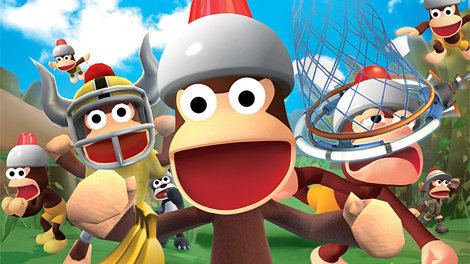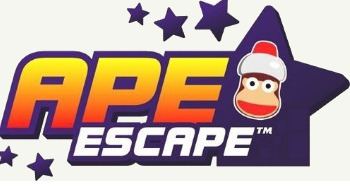Adaptations Ape Escape (2002) | ||
 | ||
Publishers Sony Computer Entertainment First release Ape EscapeMay 31, 1999 Developers Sony Interactive Entertainment, Takara, SIE Japan Studio, h.a.n.d., Shift, SIMS Co., Ltd. Games PlayStation Move Ape Escape, Ape Quest, Saru! Get You! SaruSaru, Saru! Get You! Million M, Ape Academy 2 | ||
Ape escape caddicarus
Ape Escape (known as Saru Get You (サルゲッチュ, Saru Getchu) in Japan) is a series of video games made by SCE Japan Studio, starting with Ape Escape for PlayStation in 1999. The series often incorporates ape-related humour, unique gameplay, and a wide variety of pop culture references; it is also notable for being the first game to make the DualShock or Dual Analog controller mandatory.
Contents
- Ape escape caddicarus
- Ape escape longplay
- Ape Escape Piposaru 2001 and sequel 19992003
- Pumped Primed On the Loose Ape Academy Monkey Mania and Ape Escape 3 20042005
- Ape Academy 2 PipoRacer Ape Escape Million Monkeys and Ape Escape SaruSaru Big Mission 20062007
- Ape Escape 4 Ape Quest PlayStation Move and PlayStation All Stars 2008present
- Main series
- Spin offs
- Party games
- Guest appearances
- Alternate series
- Gameplay
- Minigames
- Other media
- References

Ape escape longplay
Ape Escape, Piposaru 2001 and sequel (1999–2003)

In 1998, it was confirmed that a title would be developed under the name Sarugetchu and would be specifically designed for the DualShock controller, and would be the first game to do so. The title was a massive success, going Platinum, entering the Greatest Hits series in the US, and entered the "Best Of" releases in Japan. It was reviewed positively, and was compared to games such as Super Mario 64.
Ape Escape 2001 was released in 2001. It was the first title in the series to be developed for PlayStation 2. The next year, Ape Escape 2 was developed by Sony and first published in Japan in 2002 and in Europe and North America in 2003.
Pumped & Primed, On the Loose, Ape Academy, Monkey Mania and Ape Escape 3 (2004–2005)
After the success of all three titles that were released, Ape Escape was pushed as an official franchise. In 2003, SCEI confirmed to be working on a multi-player party game and the sequel to Piposaru 2001. There was also confirmation that the original Ape Escape was to be ported to the PlayStation Portable. Ape Escape: Pumped & Primed was released in Japan through Sony Computer Entertainment Inc. and the US through Ubisoft in 2004. Ape Escape: On the Loose was then released globally as one of the launch titles to the PlayStation Portable.
In 2005, Ape Academy (also known as Ape Escape Academy) was released for the PlayStation Portable. Eye Toy: Monkey Mania was a party game inspired by Mario Party The title was only released in Europe and Japan.
In mid-2005, Ape Escape 3 was released to positive critical reception.
Ape Academy 2, PipoRacer, Ape Escape: Million Monkeys and Ape Escape: SaruSaru Big Mission (2006–2007)
After the release of Ape Escape 3, Sony Computer Entertainment Europe showed interest in publishing Ape Academy 2 and Ape Escape: Million Monkeys, however Sony Computer Entertainment America showed more interest in developing their own title. Ape Academy 2 was released in 2006 for the PlayStation Portable to mixed success and sold very well in Japan, entering the "Best of" category, but failed to perform well in Europe, due to Sony focusing on Million Monkeys. Million Monkeys was released in Japan in July 2006, making it the last official PlayStation 2 title in the series. The game was planned to be released in the United Kingdom in late 2006, but the game was postponed and later canceled. Its impact in Japan led to Spike in his Million Monkeys incarnation to be included in the PlayStation All-Stars Battle Royale video game in 2012. In late 2006, PipoRacer was released in Japan for PlayStation Portable. In 2008, Japan Studio and h.a.n.d. developed Ape Escape: SaruSaru Big Mission. It was never released outside Japan.
Ape Escape 4, Ape Quest, PlayStation Move and PlayStation All-Stars (2008–present)
In 2006, Sony placed an advertisement in Famitsu magazine with interest in hiring staff for an upcoming title. It contained a picture, with four monkeys, with the first holding up Ape Escape, the second holding up Ape Escape 2, the third holding up Ape Escape 3 and the fourth holding a cover with "?". The fourth entry was in development. However, since it was first announced in 2006, we have yet to see this title be released. A tweet by Sony Computer Entertainment Japan on Twitter was posted on January 5th, 2016, reading, “2016 Year of the Monkey. Today, SCE will begin working! #Monkey #YearofMonkey” alongside an image of a Pipo Monkey, possibly meaning the idea of a fourth game was abandoned, but was regained and production had immediately begun.
Ape Quest was officially released in 2008 exclusively to the US PSN store, and was the first game to be developed by Sony Computer Entertainment America. It was then published by Sony Computer Entertainment Europe in May 2008 and was finally released in March 2009 in Japan. It was the first game in the series to be a PSN-only title, excluding Asia, where it received a physical release. In 2009, a game titled Ape Escape was announced along with the PlayStation Move. Fans and critics speculated that it was the fourth entry in the series, after Sony's 2006 advertisement. In Q3 2010, PlayStation Move: Ape Escape was officially announced under the party genre, and with a different name for every region. It was released in Japan in December 2010, Asia in January 2011, and the UK and Europe in mid-2012. In the US, the title was only made available on the PSN store. After the release of PlayStation Move: Ape Escape, no titles were announced in 2012, making it the first year since 2002 that no Ape Escape title had been released and the first year in the history of the franchise that no title had been announced within each region. Despite this, Spike is a character in PlayStation All-Stars Battle Royale, which was released in November 2012.
Main series
Spin-offs
Party games
Guest appearances
Main series
One of the main story elements of each of the main series involves a white-haired monkey named Specter obtaining a helmet known as the Peak Point Helmet (Pipo Helmet for short), which boosts his intelligence. After equipping an army of monkeys with Pipo Helmets, and using an enhanced helmet for himself, Specter sends his monkey army to take over the world, and Space. It is up to the game's protagonists, equipped with various gadgets, to capture the monkeys and restore order to the world.
Alternate series
The alternate series, developed by SCEI, is the alternate main series. Specter and the Monkeys take over the world, or try to sabotage players in "Pumped and Primed". In both games, Specter does not end up being the main villain and there are usually darker forces behind Specter that you will have to defeat. The villains change from game to game. It is up to the game's protagonists, equipped with various gadgets, to capture or defeat monkeys/characters, to save the day.
Gameplay
The Ape Escape series is notable for its radical departure from the tried-and-true control method in most other games. It was the first PlayStation game to require the use of a DualShock or Dual Analog controller; the left stick moves the character while the right operates whatever gadget the player has in his/her possession. Again, unlike many games which use to jump, both the R1 and R2 buttons are used, while the 'shape' buttons are used to cycle through the available items in the inventory.
In the PSP spin-offs, a more conventional control scheme must be used, due to the PSP's lack of a right analog stick.
The main objective through the majority of the games is to use your available array of gadgets to locate and capture monkeys. When a monkey has been found, he needs to be caught with the Time Net gadget. On the first through, players will have a set number of monkeys to catch before progressing towards the next level. Once each level has been completed, they can be reentered with the gadgets necessary to catch the remaining monkeys.
Minigames
In the main series, there are three unlockable minigames that can be played at the hub. These can be accessed by clearing the necessary amount of stages and/or having the necessary amount of coins. In Ape Escape and Ape Escape: On the Loose, you had to collect a certain amount of Specter Tokens to unlock a minigame.
In Ape Escape 2, you could obtain these three minigames by betting ten coins in the Gotcha Box, but here the stage-clearing was much more vital, yet it didn't mean it'd be based on your percentage on your record.
In Ape Escape 3, because coins were far more abundant than Ape Escape 2 and the fact that you could hold coins past 999, the prices went up for the mini-games as well. Another thing is that this time it was based on your percentage, so clearing stages, beating time attacks, or purchasing things from the shops would get you faster to making the mini games become available to purchase. The minigame Mesal Gear Solid seems fuller and more of a game of its own rather than just a simple unlockable. This game has a plot and more traditional gameplay of the AE series, and could be the start of more fuller minigames based on a series already established, like Metal Gear Solid.
In Ape Quest, the player randomly encounters mini-games in a very similar fashion to classic JRPG random enemy encounters.
